

Synthetic insulation is a bit of a miracle material: It’s breathable, water-resistant, and modern blends come impressively close to matching the loft and light weight of down. We’ll lounge around in our down jacket any day, but for performance use it’s all synthetic (almost) all the time, whether we’re building heat on the trail or throwing on a layer halfway up an alpine rock climb. We've put countless jackets through their paces over the years across all seasons, from casual offerings to minimalist down-mimicking designs and active insulators built for breathability. Below are our picks for the 18 best women’s synthetic jackets of the year. For more background information, see our comparison table and buying advice below the picks, along with details about our testing process. We've also put together a round-up of the best synthetic jackets, which includes both men's and women's styles.
Editor's note: We updated this guide on August 5, 2025 to add the Ortovox Swisswool Piz Boè Jacket to the list after testing it extensively in Montana, as well as Patagonia's latest addition to the Nano-Air line, the Nano-Air Ultralight. We also swept the guide to ensure all existing information was up to date at the time of publishing.
 Category: Casual
Category: Casual
Weight: 12.3 oz.
Insulation: PrimaLoft Gold Eco (60g)
What we like: A timeless classic for everyday and casual backcountry use.
What we don’t: Not particularly breathable or weather-resistant.
For a versatile synthetic jacket that gets the job done both on and off the mountain, it doesn’t get any more classic than the Patagonia Nano Puff Hoody. The Nano Puff looks and feels similar to a down jacket with a shiny baffled shell (made from recycled fishing nets) and lofty PrimaLoft Gold Eco insulation, but offers all the strengths of synthetic fill, including better wet-weather performance and breathability, along with a lower cost. And with two hand pockets, an internal chest pocket, a roomy yet lightweight build, and the choice between hooded and non-hooded designs, it has all the trimmings of a functional everyday jacket.
Scroll down the list below, and you’ll notice a number of other offerings from Patagonia. Within their synthetic jacket collection, the Nano Puff is by far the most popular, but it’s certainly not the most technically savvy. For active use, we’d reach instead for the stretchier and more breathable Nano-Air or Nano-Air Ultralight (both below); for weight-conscious activities or alpine conditions, the lighter, more packable, and more weather-resistant Micro Puff Hoody is our go-to. But for everyday use with a bit of backcountry mixed in—think casual hiking or backpacking, resort skiing, or cragging—the Nano Puff is a well-balanced, do-it-all jacket.
Read more: Patagonia Nano Puff Hoody review (men's version)
See the Patagonia Nano Puff Hoody

 Category: Casual/performance
Category: Casual/performance
Weight: 11.8 oz.
Insulation: PrimaLoft Gold PURE (40g)
What we like: Hybrid construction effectively balances breathability and warmth; eye-catching colorways and flattering fit.
What we don’t: Minimally insulated; there are cheaper options available.
Based in Salt Lake City, Cotopaxi has quickly risen to popularity thanks to their sustainable production practices and hard-to-miss colorways. Their Capa Hybrid is a case in point: The jacket features a recycled shell and insulation, and its vibrant color blocking and classy fit and finish make it fun to wear both in the mountains and around town. The "hybrid" in its name refers to the mapped construction, which comprises 40-gram insulation around the core with knit sleeves and side panels for enhanced mobility and breathability during high-intensity activities. For reference, our tester sported the Capa Hybrid while paramotor gliding last fall and was impressed by the level of warmth while flying around at 1,000 feet. Additional features include a soft lining, handy thumb loops, a flattering fit that's slim but not restrictive, and a stylish scuba-style hood that stays in place.
Like many Cotopaxi pieces we've tested over the years, we love the Capa Hybrid for its ability to pull double duty outdoors and around town. However, it's not the most versatile option here due to the lack of insulation along the sides and sleeves—for truly cold objectives, we turn to designs that boast thicker fill (at least 60g) throughout the entire jacket. To be fair, our Tennessee-based tester found the Capa Hybrid comfortable down into the 40s Fahrenheit (when moving) and wore it as a midlayer when backpacking in colder temps without issue. But it also isn’t the cheapest synthetic you can find: A less costly alternative is REI’s Co-op Trailmade Insulated Hoodie, which features a thicker 80 grams of insulation throughout the jacket (we are currently testing this jacket and will report back). Still, we think the Capa is a comfortable, flattering, and well-executed piece that—with proper layering—can handle a wide range of adventures.
See the Cotopaxi Capa Hybrid Insulated Hooded
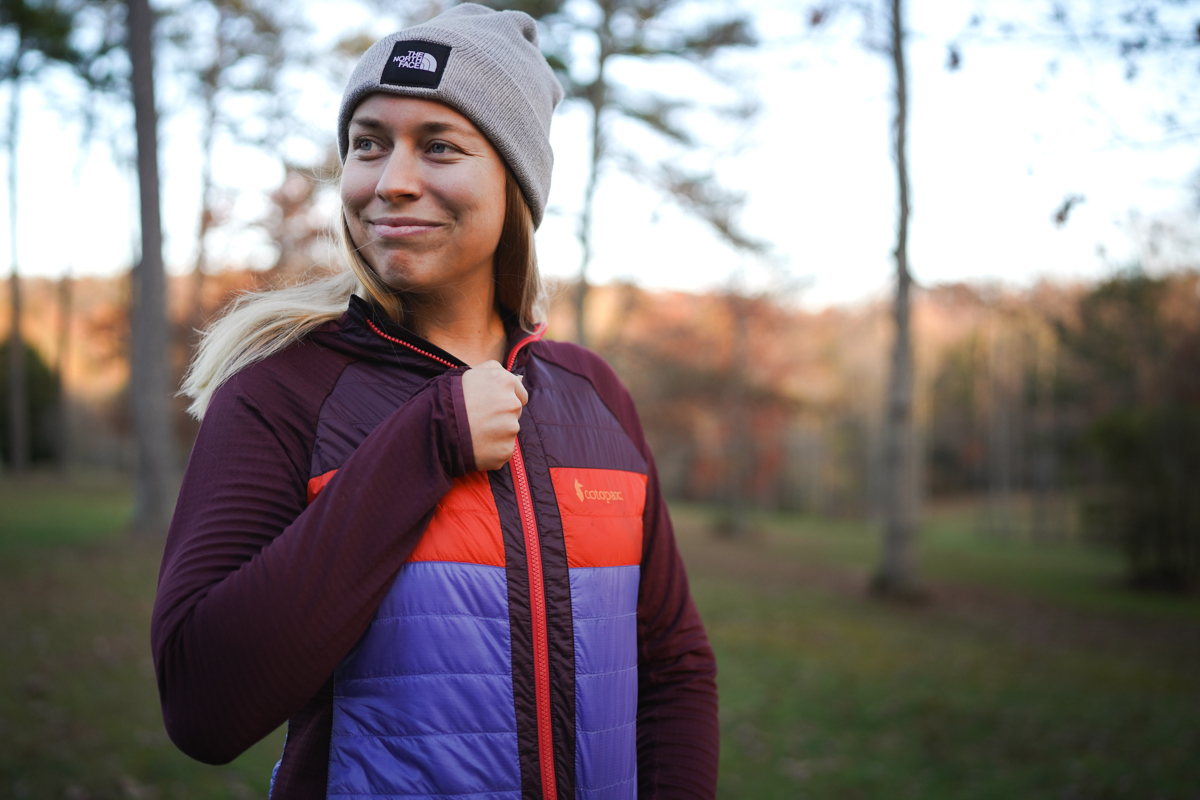
 Category: Performance
Category: Performance
Weight: 9.0 oz.
Insulation: PlumaFill (65g)
What we like: An excellent down mimicker with the performance benefits of synthetic fill.
What we don’t: Trim fit and thin shell fabric limit the jacket's everyday appeal.
For weight- and space-conscious missions like multi-pitch climbing, backcountry skiing, and ultralight backpacking, you’ll want a lightweight and packable jacket, and Patagonia’s Micro Puff Hoody is our favorite in this category. At just 9 ounces, the Micro Puff stands out as the lightest option on our list and offers impressive warmth thanks to Patagonia’s down-mimicking PlumaFill insulation, which does a great job mimicking down’s loft and compressibility. In fact, packed size is competitive with that of a down jacket of similar weight—for reference, the Micro Puff stuffs down into its left hand pocket to about the size of a 32-ounce Nalgene bottle with a built-in carabiner loop for attaching to a climbing harness. Tack on two drop-in-style pockets along the interior, a trim fit that layers nicely under a hardshell, and a functional under-the-helmet hood, and the Micro Puff is hard to beat for technical backcountry pursuits when you want to keep heft and bulk to an absolute minimum.
At first glance, the Micro Puff bears a strong resemblance to Patagonia’s own Nano Puff above, but the two have very different priorities. In addition to being an ounce lighter, the Micro Puff utilizes a thinner but more weather-resistant Pertex Quantum shell. We’d still advise packing a waterproof layer if heavy or extended rain is in the forecast, but the Micro Puff is fully windproof and has a major leg up over most down jackets when it comes to wet-weather assurance. It’s also worth noting that the Micro Puff lacks helpful backcountry features like a two-way main zipper and helmet-compatible hood—both of which you get with the brand’s DAS Light Hoody. Finally, the Micro Puff is decidedly lacking in everyday appeal with thin fabrics that require added care to avoid snags and tears. But for shoulder-season warmth in a feathery package, the Micro Puff is in a class of its own.
Read more: Patagonia Micro Puff Hoody review
See the Patagonia Micro Puff Hoody

 Category: Performance
Category: Performance
Weight: 12.7 oz.
Insulation: Coreloft Compact (80g)
What we like: A cozy, stretchy, and breathable jacket you won't want to take off.
What we don’t: Too warm for high-output use in mild conditions.
If you’re shopping around for a synthetic jacket, chances are you’ve come across the term “active insulation” in your research. In contrast to down-mimicking pieces like Patagonia's Nano Puff and Micro Puff above (which feature thin ripstop shell fabrics and offer competitive warmth for the weight), active insulators use stretch-infused shells and air-permeable insulation that prioritize mobility and breathability. They’re not particularly lightweight or wind-resistant, but they’re by far the more ideal insulator for heat-generating activities like cross-country skiing, ski touring, winter running, cold-weather backpacking, and more. Arc'teryx's Proton Hoody headlines this category with a soft, stretchy, and breathable construction that moves with you and a "fitted" silhouette that doesn't get in the way.
The Proton Hoody is a put-it-on-and-leave-it-on type of jacket—in fact, if you're anything like us, you'll even want to wear it around the house. What's more, the stretchy Fortius shell fabric can really take a beating, which is especially helpful around sharp equipment and surfaces like skis or ice tools, climbing gear, and gritty alpine rock. However, keep in mind that the Proton is too much jacket for mild temperatures or real-deal redlining—for that, we turn to designs like the Outdoor Research Deviator below, which uses lightweight synthetic fill at the front and thin fleece at the back, sides, and underarms for improved breathability. But for mid-winter hikes or ski touring, the Proton Hoody is tough to beat.
See the Arc'teryx Proton Hoody
 Category: Performance
Category: Performance
Weight: 11.8 oz.
Insulation: VerticalX Octa
What we like: Best-in-class mobility and breathability for shoulder-season conditions.
What we don’t: Not as warm as most jackets here.
The Proton above is a wonderfully cozy and breathable jacket for chilly temps, but you’ll want something lighter for mild conditions or truly high-output use. In these scenarios, our favorite active insulator is the Outdoor Research Deviator Hoodie. This jacket offers an intelligent combination of lightweight synthetic fill (VerticalX Octa) at the front and thin fleece at the back, sides, and underarms. VerticalX Octa is unique in that it doesn’t require a liner, which works wonders when you’re working up a sweat: The exposed insulation efficiently wicks moisture and feels uber-plush next to the skin (we often layer just a t-shirt underneath). Tack on stretch-woven softshell fabric with a DWR finish at the front (20D), and the Deviator is one of our go-to jackets when moving quickly through a range of shoulder-season weather.
The Deviator isn’t as insulative as most jackets here—the VerticalX Octa is much thinner than standard 60-gram fill, and the panels of fleece don’t do much to keep out the wind—but it’s a good example of less is more. This design is ideal for when jackets like the Proton or Micro Puff above are just too much—whether you’re running, climbing, biking, Nordic skiing, etc.—and the wind- and water-resistant front offers a nice dose of assurance compared to a standard fleece jacket. Keep in mind that the Deviator is meant to fit particularly snug, but we’ve found this to be ideal for active use. Within this category, it’s also worth checking out The North Face’s Summit Series Casaval Hybrid Hoodie below, which is outfitted with 60 grams of Ventrix insulation in a more durable 40 and 75D shell. The Deviator is a bit cheaper and thinner, however, which secures it as our favorite layer for heart-pumping endeavors.
See the Outdoor Research Deviator Hoodie

 Category: Casual/performance
Category: Casual/performance
Weight: 11.3 oz.
Insulation: Coreloft Compact (60g)
What we like: A durable yet comfortable jacket for both front- and backcountry use.
What we don’t: Does not excel in any particular performance category.
Arc'teryx's venerable Atom collection has been a consistent favorite of ours over the years, and the flagship design has a lot to offer. This synthetic hoody strikes a nice balance for both casual and performance use with a durable yet soft 100%-nylon shell, stretchy fleece side panels for comfort and ventilation, and Arc’teryx’s celebrated StormHood, which is helmet-compatible and comes complete with a small brim. We also love the sleek look and variety of classy colorways to choose from, making it a great around-town piece. You don't get the air permeability of a design like Arc'teryx's own Proton above or Patagonia's Nano-Air below, but the Atom is cozy, hardwearing, and boasts the top-notch build quality we've come to expect from Arc'teryx.
The Atom Hoody was our first-ever synthetic jacket way back in the early 2010s, and it still has a place in our hearts as a versatile, durable, and comfortable mid- and outer layer. For comparison’s sake, the Atom’s face fabric cuts wind and resists wear a bit better than that of the Nano-Air below, and it’s certainly softer and cozier than a down-mimicking piece like the Nano Puff above. That said, it's a bit bulky for light-and-fast missions and doesn't provide the level of weather resistance we look for in a backcountry layer. But no jacket is perfect, and the Atom's all-around versatility earns it a respectable finish on our list this season.
Read more: Arc'teryx Atom Hoody review (men's version)
See the Arc'teryx Atom Insulated Hoody
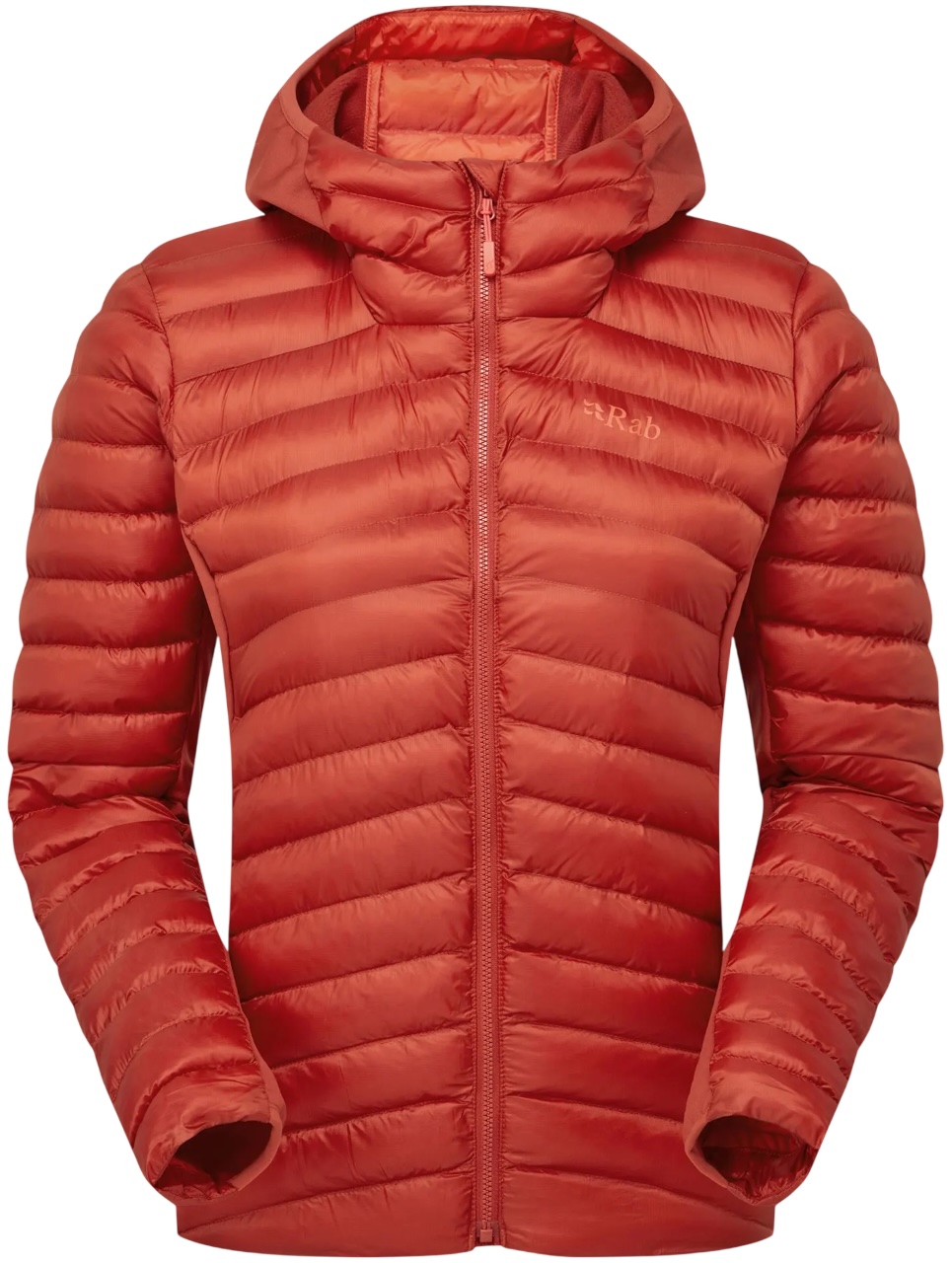 Category: Performance
Category: Performance
Weight: 13.4 oz.
Insulation: PrimaLoft Silver (130g)
What we like: A versatile and mountain-ready synthetic jacket at a great price.
What we don’t: Not super weather-resistant.
U.K.-based Rab is no stranger to variable alpine conditions, and their Cirrus Flex is a great companion for serious mountain-goers. This mid-range jacket combines thick PrimaLoft Silver Rise fill with a durable 20-denier Pertex Quantum shell, resulting in the look of a down puffy with all of the performance characteristics of synthetic. The down-like insulation and 100%-nylon shell don’t add up to great breathability, but Rab tacked on stretchy underarm panels that are effective at dumping heat. The feature set also includes internal stash pockets and a packable design, both of which we love for activities like climbing and skiing. A final bonus: The latest model has a very sleek look with larger baffles than the prior version, which also translates to fewer seams.
You’d be hard-pressed to find a better value than the Cirrus Flex, and you can save a bit more by opting for the non-hooded version. While its baffled design makes it more susceptible to gusts, it still boasts an impressive amount of warmth for its weight. We’re big fans of the stretchy side panels, which make it a great midlayer option for activities like resort skiing and winter hiking. Keep in mind that the Cirrus Flex runs fairly small—we recommend trying it on before buying, as you’ll likely want to size up. And for a step up in warmth, Rab’s Cirrus Alpine features a thicker shell fabric (30D) and more insulation but lacks the Flex’s stretchy side panels, weighs more at 1 pound, and costs a bit more.
See the Rab Cirrus Flex Insulated Hoodie
 Category: Performance
Category: Performance
Weight: 14.8 oz.
Insulation: Ventrix (60g & 40g)
What we like: Best-in-class breathability and backcountry-ready athletic cut.
What we don’t: Not as wind-resistant as most jackets here; design doesn’t cross over well for casual use.
The North Face’s Summit Series is known for high-performance gear that serves the needs of some of the world’s best athletes, and the Casaval Hybrid is no exception. In the same category as the Arc'teryx Proton above and Patagonia Nano-Air below, this active insulator combines 60-gram Ventrix insulation with a sweatshirt-like shell that TNF markets as “high CFM,” denoting high breathability and minimal windproofing. The insulation is perforated at the back for additional venting, and stretch-woven (read: uninsulated) fabric at the hem and under the arms adds freedom of movement and comfort when worn with a backpacking pack or harness. Added up, the Casaval Hybrid is a purpose-built jacket for sweat-inducing activities like backcountry skiing, mountaineering, and rock climbing.
Aside from the Casaval Hybrid’s chart-topping breathability, one of our favorite features is its fit. The jacket is fairly streamlined, and the stretch-woven fabric at the hem offers a tailored look and feel. What’s more, durability is excellent: We’ve used and abused the Casaval on various alpine climbs, backcountry ski outings, and during a 124-mile traverse of the North Cascades, and its fabric has yet to pill or abrade (it has amassed a few minor holes and stains). The primary downside to the TNF is its lack of warmth and windproofing, although you’ll likely appreciate this trade-off when generating your own heat. At a lower price than the Nano-Air, the Casaval Hybrid is well worth a closer look.
See the The North Face Summit Series Casaval Hybrid
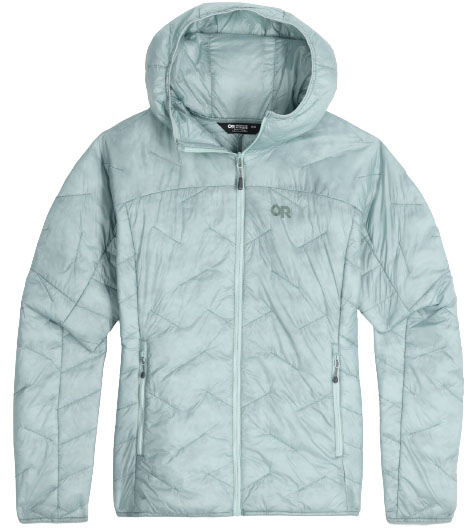 Category: Performance
Category: Performance
Weight: 9.6 oz.
Insulation: VerticalX SuperStrand
What we like: A lightweight and packable synthetic for considerably less than the Micro Puff.
What we don’t: Not very warm and shell fabric wets out in light moisture.
Outdoor Research is a great one-stop shop for value, with mid-range products that often retail for noticeably less than the competition. The SuperStrand LT is their performance-oriented synthetic, giving lightweight pieces like Patagonia’s Micro Puff above a run for their money. We’ll start by saying that there is a lot to like about this jacket: The VerticalX SuperStrand insulation does a great job mimicking down and results in a relatively lightweight 9.5-ounce build that packs into its left hand pocket; the nylon shell is noticeably soft and cozy (we find ourselves reaching for the SuperStrand LT more than almost any jacket in our quiver); and the fit is spot-on. And importantly, it’s priced considerably less than the aforementioned Patagonia offerings
You’d be hard-pressed to find a more lightweight and packable synthetic jacket at this price, but the Outdoor Research SuperStrand is not without its compromises. True to the “LT” in its name, the SuperStrand lacks features like a hem or hood adjustment, chest pocket, and internal wind flap behind the front zipper. What’s more, it’s quick to wet out in a light rainfall, not particularly wind-resistant, and we’ve noticed that the synthetic fill has a tendency to creep out through the seams. But if cost savings is your priority and you plan on taking along a hardshell or rain jacket, the OR is a nice middle ground that won’t weigh you down.
Read more: Outdoor Research SuperStrand LT Hoodie review
See the Outdoor Research SuperStrand LT Hoodie
 Category: Performance/casual
Category: Performance/casual
Weight: 12.4 oz.
Insulation: FullRange (60g)
What we like: Best-in-class comfort.
What we don’t: Doesn’t excel in any single performance category.
The Nano-Air from Patagonia may not be our top-rated synthetic jacket, but it wins outright in one important category: comfort. This pillowy synthetic feels like a combination of a high-end performance piece and your favorite sweatshirt with a very soft, stretchy, and breathable construction. Climbers and active folks will love its ability to move and breathe (the FullRange insulation and stretchy shell are noticeably airier than what you get with Arc'teryx's Atom above), and you simply won’t find a cozier piece for daily use or travel. Back when the jacket was introduced, Patagonia advertised it as a “put it on, leave it on” piece, which is a good synopsis of the Nano-Air's appeal (similar to the warmer Arc'teryx Proton above).
However, despite having a price tag that rivals many of our top picks, the Nano-Air Hoody doesn’t shine in any single performance category. It’s fairly heavy at 12.4 ounces, takes up a good amount of space in a pack, isn’t particularly weather-protective (you do get a PFAS-free DWR coating), and has a roomier fit than the Arc'teryx Proton above, which makes it less ideal for active use. But for daily wear, casual backpacking, and even resort skiing, you won’t find a more comfortable jacket.
Read more: Patagonia Nano-Air Hoody review
See the Patagonia Nano-Air Hoody
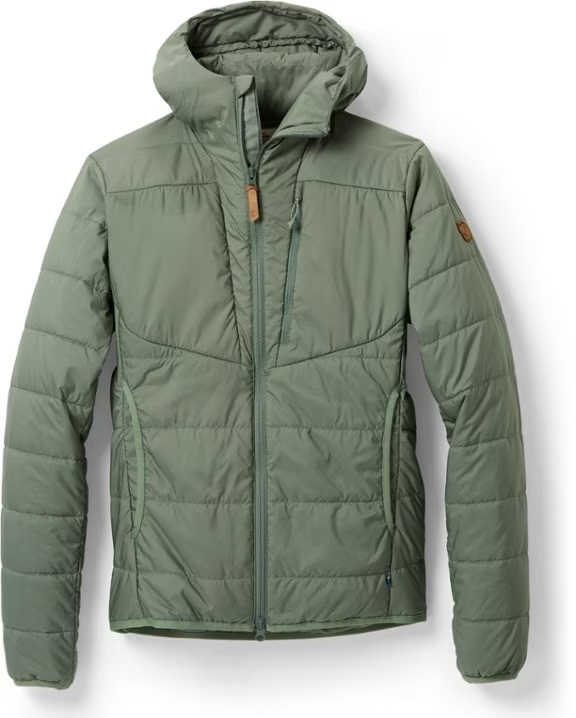 Category: Casual
Category: Casual
Weight: 1 lb. 0.2 oz.
Insulation: PrimaLoft Black (60g)
What we like: Classy Fjallraven vibes and premium build quality.
What we don’t: Heavy; no zippers on the hand pockets.
Many of the designs on this list have a performance slant, but few can match the casual appeal of the Keb Padded Hoodie. Simply put, this is one of the best-looking synthetic jackets on the market with Fjallraven’s signature classy aesthetic. On the outside, the Keb features creative baffling that elevates its style from that of a standard puffy, while the 100%-polyester shell is available in an assortment of sophisticated colorways. On the inside, PrimaLoft Black insulation traps air like down and provides ample warmth for temperatures into the 40s Fahrenheit. Added up, you get a premium urban jacket that can also pull double duty for light fall and winter adventuring.
Like most Fjallraven apparel, the Keb Padded Hoodie has its limitations for performance use. Without a doubt, you don’t get the high-tech insulation of similarly priced jackets from brands like Arc’teryx and Patagonia, which means that breathability and packability aren’t as good. What’s more, the Keb is one of the heaviest offerings here at over a pound, and the choice to forgo zippers on the hand pockets solidifies it as a casual piece. But everyday users will appreciate the durable shell, and details like hood and hem adjustments, a two-way main zipper, and ample pockets keep things functional. For a more performance-oriented option from Fjallraven, check out the Expedition X-Latt, which has a much lighter build (9.9 oz.) and is more ideal for active pursuits like backpacking and backcountry skiing.
See the Fjallraven Keb Padded Hoodie
 Category: Performance
Category: Performance
Weight: 9.5 oz.
Insulation: PrimaLoft Gold Active+ (60g & 40g)
What we like: A quality active insulator at a great price and competitive weight.
What we don’t: More specialized and less of an all-rounder than the Nano-Air.
Patagonia's Nano-Air above is one of our favorite active insulators, but Rab’s Xenair Alpine Light Jacket will save you some weight and cash while still checking most of the boxes we look for in a high-quality piece. For around 3 ounces less, the Xenair manages to pack in a ton of useful features, including two zippered hand pockets, a close-fitting hood that slides nicely under a helmet, and an internal chest pocket that doubles as the stuff pocket. The 20-denier Pertex Quantum Air shell also offers a slight step up in breathability, and Rab strategically placed thicker insulation (60g) along the chest, back, and front of the arms to maximize warmth in key areas (thinner 40g is used under the arms and along the sides).
What’s not to like with the Rab Xenair Alpine Light? While lighter and cheaper than the Nano-Air, the Patagonia wins out in storage with an additional pocket and is the warmer option with 60-gram insulation throughout. Speaking of warmth, the Xenair Alpine Light is underbuilt for true heart-of-winter use—if that's what you're after, Rab offers the standard Xenair Alpine Insulated Jacket, which utilizes much thicker 133-gram fill (the same PrimaLoft Gold Active+). Finally, the Xenair Alpine Light’s Quantum Air shell clearly prioritizes breathability over wind and water protection. These complaints aside, the Xenair is an excellent value for what you get and a strong alternative to the Nano-Air for those looking to save.
See the Rab Xenair Alpine Light Insulated Jacket
 Category: Performance
Category: Performance
Weight: 11.6 oz.
Insulation: PrimaLoft Gold Eco (60g)
What we like: A durable backcountry layer at a good price.
What we don’t: Not a standout in comfort; climbers would benefit from a couple added features.
Black Diamond is no stranger to arduous backcountry travel, and their Solution Hoody nicely reflects the brand's mountain expertise. Like our top-ranked Nano Puff above, the Solution features 60-gram PrimaLoft Gold Eco insulation, though it forgoes the Patagonia's tightly boxed baffles for a sleeker, cleaner look. In testing, we found the 20-denier nylon shell to be impressively durable, handily fending off snags and tears from sharp sticks and rough sandstone while bouldering in Tennessee. In line with its backcountry intentions, the Solution can be stuffed into its left hand pocket and clipped to a climbing harness via the inside loop. Plus, its regular fit makes it easy to pair a midlayer underneath or throw on a windbreaker jacket overtop for a boost in warmth and protection.
After testing the Solution Hoody last fall and winter, we came away generally impressed by its performance on day hikes and casual climbing outings. However, there are a few details we think Black Diamond could improve upon. For one, we wish the Solution had a softer lining for better next-to-skin comfort. Additionally, we really missed having a two-way zipper and harness-compatible hand pockets on climbing objectives. We also found it to be a bit lacking in warmth during extended periods of inactivity (e.g., belaying), although the adjustable hem and stretch knit cuffs certainly help keep the wind at bay. At the end of the day, the Solution doesn't stand out in many ways, but we think its durable construction, versatile fit, and fair price tag make it a fine choice for committed backcountry enthusiasts.
See the Black Diamond Solution 2.0 Hoody
 Category: Performance
Category: Performance
Weight: 7.6 oz.
Insulation: FullRange (20g)
What we like: Truly an ultralight synthetic for moving fast in mild weather.
What we don’t: Not a true winter jacket, and we’ve had issues with durability.
Most jackets in this list have insulation hovering around 40 to 80 grams, but the Nano Air Ultralight’s 20 grams of FullRange insulation is hardly noticeable in hand. When on, however, the sparse insulation has proved just right for spring ski tours, trail runs, and alpine rock climbing. Like many of the other active insulators here, the Nano Air Ultralight features uninsulated underarm panels (Patagonia’s Capilene Cool Lightweight fabric) that provide stretch and breathability in high-sweat areas. The ripstop nylon shell is reinforced with a PFAS-free DWR, and we found it surprisingly effective at cutting wind on gusty summits. When you find yourself caught in wetter weather, the jacket’s athletic fit slides easily under a hardshell. Lastly, as the name suggests, the Nano Air Ultralight is the lightest weight (7.6 oz.) and most packable layer on this list, giving it a lot of appeal for those trying to keep things fast and light.
It should come to no surprise that the Nano Air Ultralight isn’t best suited for truly cold conditions—you’ll want to bring a hardshell jacket if there’s any kind of precipitation in the forecast, or if you plan on facing strong winds. And unless you’re trying to set mid-winter FKTs, a heavier jacket is essential for lunch breaks or belays. We also have concerns with the long term durability of this piece. Though the 30D shell seems resistant to tearing, it has shown some early signs of wear. The Capilene panels also seem particularly prone to damage. And in true ultralight fashion, the Nano Air Ultralight is trim in terms of features. Patagonia included a chest pocket that can hold on-the-go snacks, but there are no hand pockets for warming the digits or storing anything larger than an iPhone. In the end, we think the Nano Air Ultralight jacket is a bit specialized, and most discerning athletes can accomplish something similar with a windbreaker and insulated vest. But if ultralight is really what you’re after, this jacket is worth a look.
See the Patagonia Nano-Air Ultralight Hoody
 Category: Performance/casual
Category: Performance/casual
Weight: 13.2 oz.
Insulation: PrimaLoft Gold Active (80g & 60g)
What we like: More affordable than most active insulators.
What we don’t: Simple feature set and no additional venting.
If active insulators like the Proton and Nano-Air above have caught your eye, it’s also worth taking a look at Mountain Hardwear’s Kor Stasis. For a bit less than the competition, the Kor Stasis still pulls off a competitive build that places a high priority on breathability and mobility. Mountain Hardwear picked out some prime materials for the job: Pertex’s Quantum Air (20D) shell is noticeably air-permeable, while the PrimaLoft Gold Active insulation (80g throughout the body and upper sleeves and 60g at the hood and lower sleeves) features a healthy amount of stretch. Put it all together, and the Kor Stasis is an affordable and functional insulator for high-output winter pursuits like running, ski touring, and Nordic skiing.
The main compromise of the Kor Stasis comes in terms of features: With no hem or hood adjustment, no internal dump pockets, and a simple construction that forgoes additions like stretch-woven or fleece panels, Mountain Hardwear’s jacket is decidedly simple. And as a result of this no-frills (and no vents) design, its breathability falls short. For better-ventilated insulators at an even lower price, check out the Casaval Hybrid and Xenair Alpine Light above. But if you don’t mind the extra dose of warmth (particularly for wind-generating activities like biking and Nordic skiing), it’s hard to find fault with the Kor Stasis. It’s also worth mentioning Mountain Hardwear’s Ventano Hoody, a down-mimicking synthetic jacket that, also undercuts much of the competition in term of price.
See the Mountain Hardwear Kor Stasis Hoody
 Category: Performance
Category: Performance
Weight: 1 lb. 2.4 oz.
Insulation: PrimaLoft Gold Eco (133g & 40g)
What we like: Impressive warmth and weather protection for cold and wet conditions.
What we don’t: Overkill for most uses.
Since its debut literally decades ago, Patagonia's DAS Parka has been a go-to synthetic jacket for winter climbers due to its impressive warmth and weather protection in a lightweight package. Not only is it the warmest synthetic jacket in Patagonia's lineup, but it's also the most insulative option on our list with a mix of 133-gram PrimaLoft Gold Eco fill throughout and an extra layer of 40-gram fill around the core. To be sure, the DAS is so warm that you won't want to keep it on during any sort of movement, but it’s an ideal choice for cold belays, breaks while skiing, and other low-output activities. And to keep you protected, the DAS features a highly weather-resistant Pertex Quantum Pro shell coated with polyurethane for added assurance against tears and snags.
The DAS Parka is clearly built to take a beating and has held up very well throughout our testing despite its noticeably thin (10D) shell fabric. It has all the trimmings for performance use, too, including an alpine helmet-compatible hood, a two-way front zipper that's backed by a wind flap, large internal dump pockets (great for stashing gloves, climbing shoes, or climbing skins), and elasticized cuffs that double as thumb loops. With a high price tag and a weight north of a pound, you’ll have to ask yourself if you really need the next-level warmth of the DAS Parka, but for chilly and damp conditions when down simply isn't an option, it's tough to beat. Note: The DAS Parka is low on stock at the time of publishing, but a new version should be available soon. We’ll be sure to report back on our experiences with the updated version after testing.
Read more: Patagonia DAS Parka review
See the Patagonia DAS Parka
 Category: Performance
Category: Performance
Weight: 11.5 oz.
Insulation: 80% Swisswool (60 gsm), 20% synthetic
What we like: A smartly designed, wool-synthetic hybrid jacket made for high-output winter activity.
What we don’t: A little tight through the shoulders; expensive.
German-based Ortovox stretches the definition of synthetic insulator with their wool-insulated Swisswool Piz Boè Jacket. Though more often found in baselayers, wool is a popular insulator due to its warmth-to-weight ratio, natural odor-resistance, and softness. More importantly, it still retains its ability to trap heat when wet, like traditional synthetic insulation. The Piz Boè has won us over for its techy vibe, athletic fit, and premium build, which includes a Pertex Quantum shell that’s wind- and water-resistant. The design is well-rounded with mapped paneling on the front and back which feature Otovox’s Swisswool lining (wool combined with synthetic fibers) and a thinner four-way stretchy material along the underarms and side body that allow for effective heat-dumping. What’s more, the chest pocket is easy to access while carrying a pack, and the hood stays tight around the face, even in high winds.
There are a few notable downsides regarding the Piz Boè. Most glaringly is the price, which ranks among the most expensive on this list. It’s also a very specialized piece, and we’ve had better luck with versatility in layering: A combination of a soft shell, vest, and lightweight baselayer provides a similar amount of warmth with the option of shedding a layer when the temperatures rise. We also found it to be a bit tight through the shoulders, especially for our testers with larger chests and arms. You can size up if you want, though you'll lose some of the performance-tailored fit. But so long as you like the way it fits, the Piz Boè is an excellent choice for high-output activities, such as ski touring, winter runs, and nordic outings.
Ortovox Swisswool Piz Boè Jacket
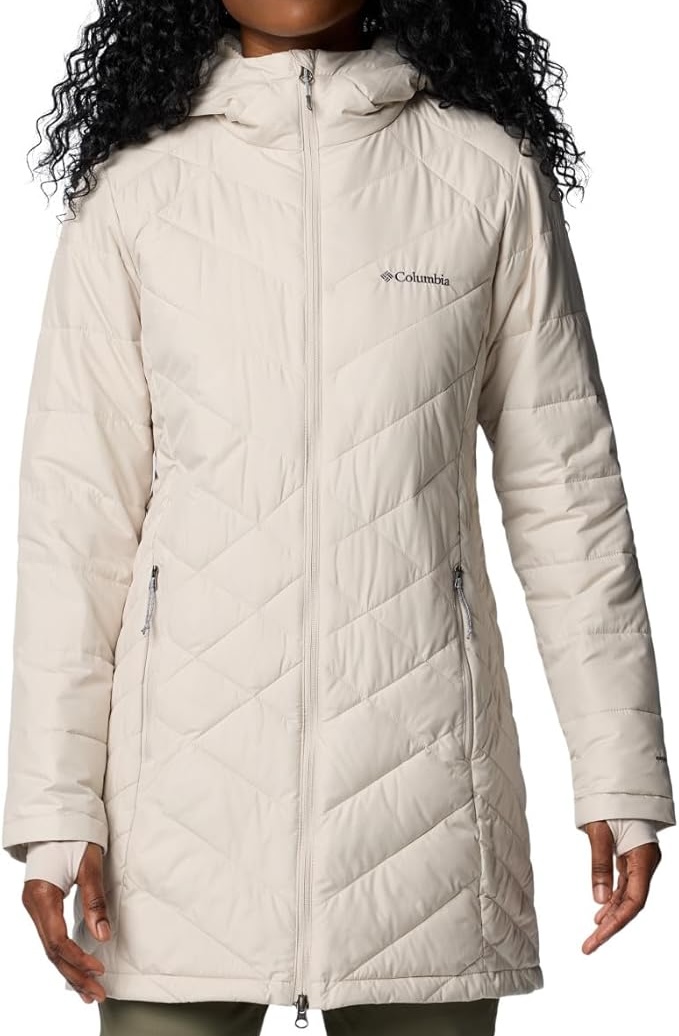 Category: Casual
Category: Casual
Insulation: Omni-Heat Reflective
What we like: Classy mid-thigh length at a great price.
What we don’t: Not as warm as most jackets here.
If you’re in the market for a casual insulated jacket for everyday use, give the Columbia Heavenly Long a closer look. The Heavenly’s mid-thigh length offers a sophisticated look that you won’t get from more backcountry-ready jackets, and the extra coverage translates to more warmth below the waist, too. It’s true that Columbia’s Omni-Heat Reflective insulation can’t match the loft or performance of higher-end offerings like PlumaFill, PrimaLoft, or Coreloft, but it’s enough to cut the chill on shoulder-season days around town, and is easier on your wallet, too.
Many women will opt for a loftier down parka for everyday winter use, but synthetic jackets certainly have their place. We especially like the Heavenly Long for milder and wetter climates like the Pacific Northwest, where temperatures rarely drop below freezing and moisture hangs in the air all winter. What’s more, the jacket’s svelte silhouette means it can layer well under a rain shell, such as the thigh-length Outdoor Research Aspire Trench. And if you prefer a more versatile hip-length jacket, Columbia also offers the Heavenly with a 27-inch center back length (compared to the Long’s 34-in.), which comes in both hooded and non-hooded varieties.
See the Columbia Heavenly Long Hooded Jacket
| Jacket | Price | Weight | Insulation | Fabric | Packable |
|---|---|---|---|---|---|
| Patagonia Nano Puff Hoody | $289 | 12.3 oz. | PrimaLoft Gold Eco (60g) | 20D | Yes |
| Cotopaxi Capa Hybrid | $180 | 10.0 oz. | PrimaLoft Gold Pure (40g) | Unavail. | Yes |
| Patagonia Micro Puff Hoody | $329 | 9.0 oz. | PlumaFill (65g) | 10D | Yes |
| Arc'teryx Proton Hoody | $350 | 12.7 oz. | Coreloft Compact Gold (80g) | 20D | No |
| OR Deviator Hoodie | $229 | 11.8 oz. | VerticalX Octa | 20D | No |
| Arc'teryx Atom Insulated | $300 | 11.3 oz. | Coreloft Compact (60g) | 20D | No |
| Rab Cirrus Flex Insulated | $185 | 13.4 oz. | PrimaLoft Silver (130g) | 20D | Yes |
| TNF Summit Casaval Hybrid | $260 | 14.8 oz. | Ventrix (60g & 40g) | 40D & 75D | No |
| OR SuperStrand LT Hoodie | $235 | 9.5 oz. | VerticalX SuperStrand | 12D | Yes |
| Patagonia Nano-Air Hoody | $329 | 12.4 oz. | FullRange (60g) | 10D | Yes |
| Fjallraven Keb Padded | $250 | 1 lb. 0.2 oz. | PrimaLoft Black (60g) | Unavail. | No |
| Rab Xenair Alpine Light | $225 | 9.5 oz. | PrimaLoft Gold Active+ (60g & 40g) | 20D | No |
| Black Diamond Solution 2.0 | $299 | 11.6 oz. | PrimaLoft Gold Eco (60g) | 20D | Yes |
| Patagonia Nano-Air Ultralight | $249 | 7.6 oz. | FullRange (20g) | 30D | Yes |
| Mountain Hardwear Kor Stasis | $275 | 13.2 oz. | PrimaLoft Gold Active (80g & 60g) | 20D | Yes |
| Patagonia DAS Parka | $449 | 1 lb. 2.4 oz. | PrimaLoft Gold Eco (133g & 40g) | 10D | Yes |
| Ortovox Swisswool Piz Boè | $320 | 11.5 oz. | Swisswool (60g wool + polyactide) | 20D | No |
| Columbia Heavenly Long | $160 | Unavail. | Omni-Heat Reflective | Unavail. | No |
The female editors at Switchback Travel know the value of a quality synthetic jacket, whether we’re trekking deep into the backcountry with a full backpacking pack or braving wintertime conditions while cross-country skiing or touring. Compared to down jackets, synthetics offer much better assurance in inclement weather—synthetic fill maintains its insulating properties when wet, while down tends to clump up—and are generally more breathable and comfortable to boot. As a result, many of the 18 designs above have seen a lot of time outside, from being toted up multi-pitch climbs to stuffed haphazardly in our packs. When testing these pieces, we focus on key performance metrics like warmth, breathability, weather resistance, and durability—all of which we break down in more depth below. Of course, each person’s needs will vary depending on their objectives and intended use(s), which is why we made a concerted effort to diversify the picks above.
This round-up was kicked off in 2023 with 18 jackets picked by former senior editor Jenny Abegg. As a native to the gloomy Pacific Northwest, Jenny knows what makes or breaks a synthetic jacket and curated the list with her years of backpacking, multi-pitch climbing, and mountaineering in mind. Editor Maddie Downie took over the guide in 2024 and loves putting synthetic jackets to the test on technical and casual adventures alike—from backcountry skiing in the North Cascades to cozying up with a good book. As the market evolves, we’ll continue staying on top of new and noteworthy releases, fine-tuning our list based on how their performance stacks up to the picks currently featured above. Finally, it's worth noting that we took a similar approach with our round-up of the best synthetic jackets, which comprises both men's and women's styles.
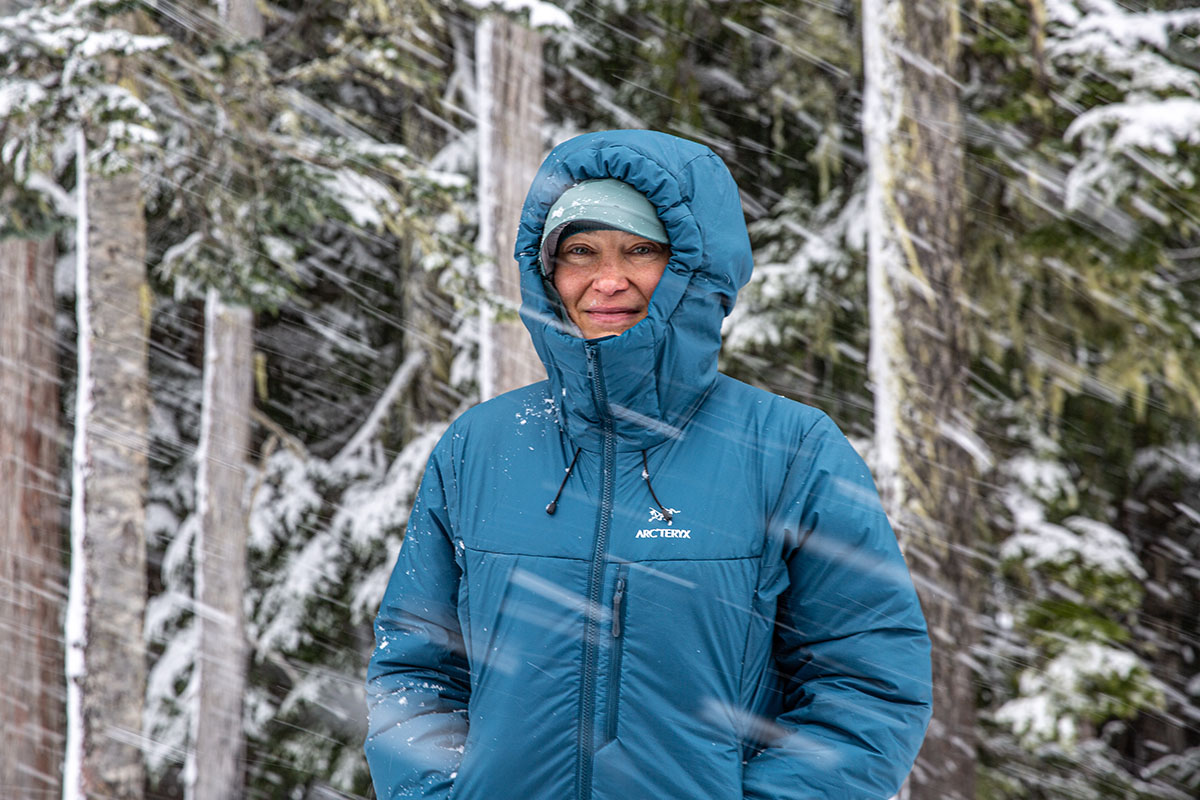
On our list above, we break synthetic jackets into two main categories: performance and casual. Performance-oriented synthetic jackets are our first choice for activities like backpacking, ski touring, Nordic skiing, alpine climbing, and other backcountry endeavors. Depending on whether they’re down-mimicking or active insulators (more on this below), they’ll have different priorities: either a lightweight and packable build (and sometimes weather resistance) on one hand—or mobility, comfort, and breathability on the other. Either way, you get premium shell materials, high-end insulation, and features like helmet-compatible hoods, internal dump pockets, and intelligent patterning that maximizes ventilation. Performance jackets are often fairly trim-fitting (great for layering under a hardshell or rain jacket) and forgo any unnecessary style features in the name of weight-savings.
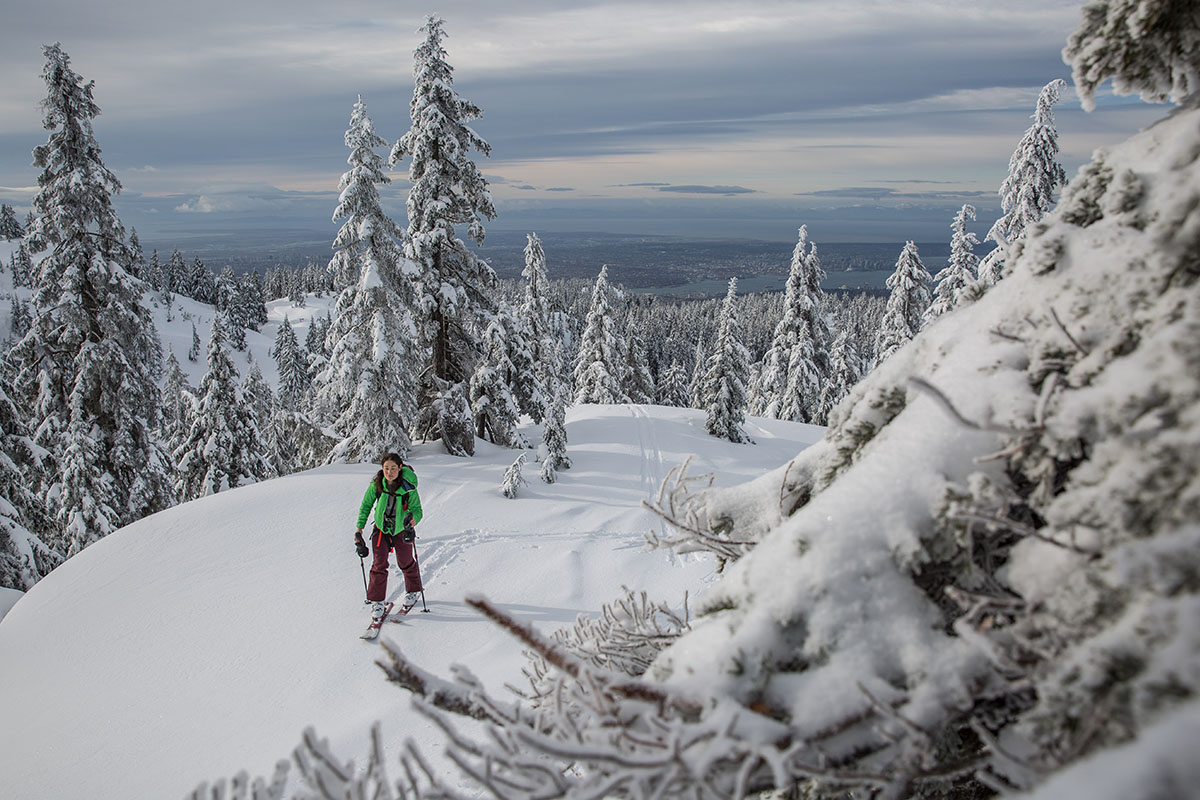
On the other hand, jackets within the casual category are our top picks for daily use, whether you’re commuting to work, running errands around town, or even logging a few laps at the ski resort. These jackets function well as outer layers, with roomier dimensions, decorative baffling (the Fjallraven Keb Padded) or vibrant colorways (Cotopaxi's Capa Hybrid), and durable shells. And more than performance-oriented jackets, casual pieces offer the choice between hooded and non-hooded versions. For cutting the chill on shoulder-season days around town, it really doesn’t get much better than a synthetic jacket—and they’re generally more durable and weather-resistant than down insulators, too.
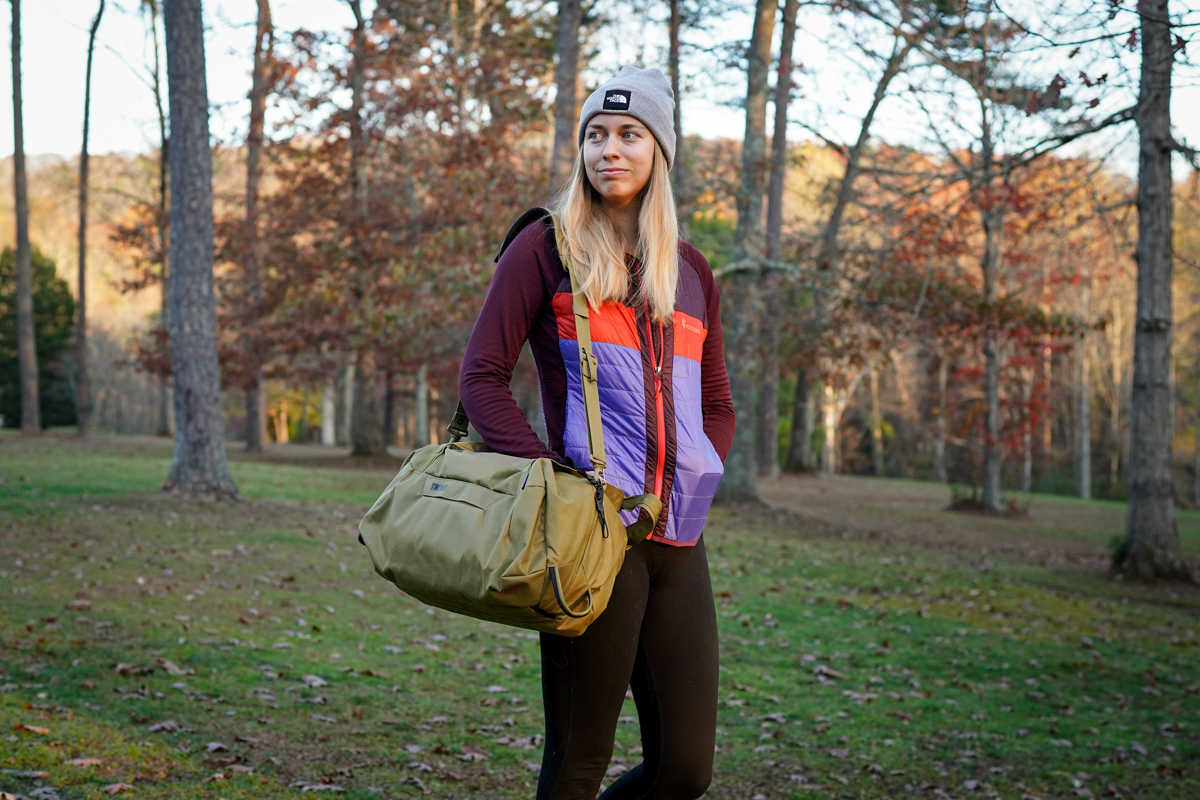
In general, we see two main styles of synthetic insulated jackets: those that aim for maximum warmth at a minimum weight and packed size (similar to a down jacket) and breathable offerings intended primarily for active use. Between these two categories, the key differences include the style of synthetic fill and the weight and makeup of the shell fabric. When considering which synthetic insulated jacket is best for you, choosing between these two categories is a great place to start.
Down-Mimicking Insulation
Synthetic insulated jackets that mimic the style and function of down jackets are great for those concerned primarily with maximizing warmth and minimizing weight and bulk. These jackets pair thin, 100% nylon shells with synthetic filaments and fibers that look and act much like down (Patagonia’s PlumaFill and The North Face’s ThermoBall are two of the biggest names). Like down puffies, jackets in this category aren’t particularly good breathers; on the other hand, they’re decently weather-resistant—especially those with Pertex Quantum Pro shells. Added up, down-mimicking synthetic insulators are great options for low-output endeavors or activities that prioritize weight-savings. Some of our favorite jackets in this category include the Patagonia Nano Puff and Micro Puff, Outdoor Research, and SuperStrand LT.
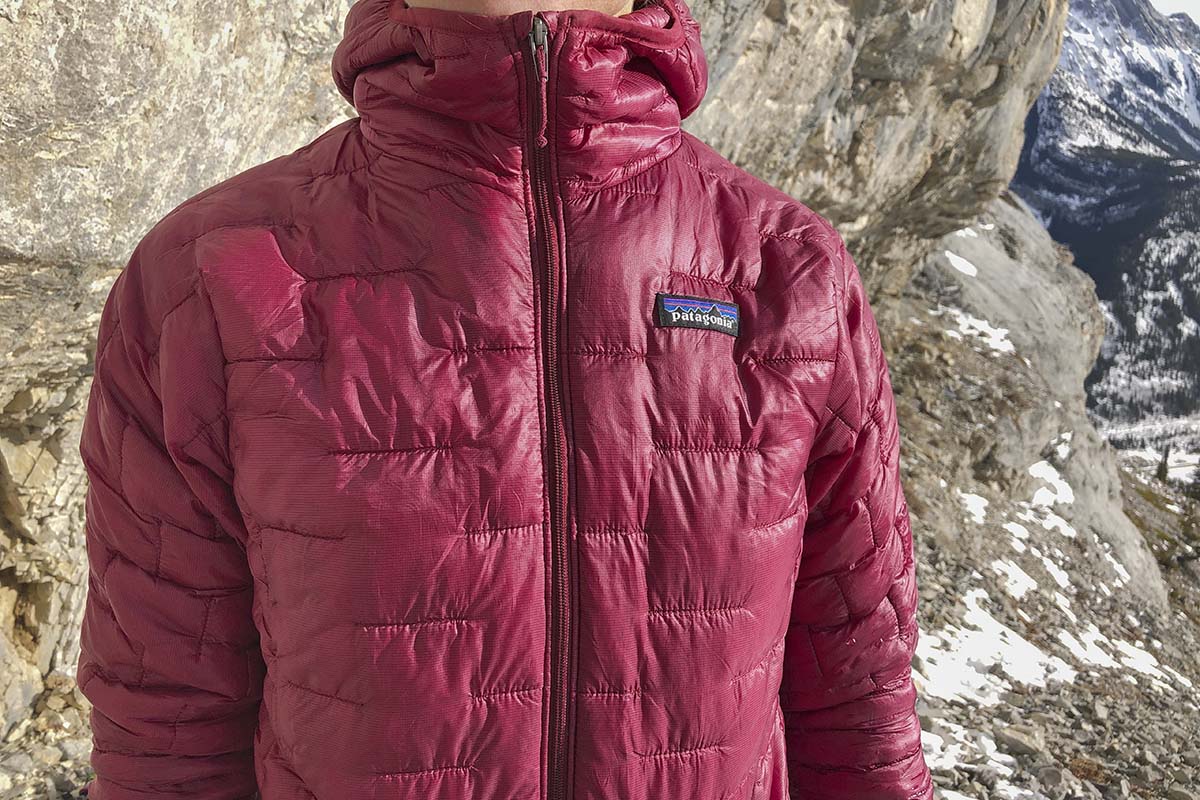
Active Insulation
For high-output activities like backcountry skiing and hiking, we look to synthetic jackets in the active insulation category. These jackets feature soft and stretchy shell materials and sheets of synthetic insulation that don’t require baffles to keep them in place (common names include Coreloft and FullRange). While this style of insulation doesn’t mimic down plumage, it still does a great job trapping heat—albeit with more bulk and weight. Due to their more sweatshirt-like material, active insulation pieces move and breathe remarkably well but are less wind- and water-resistant than the all-nylon shells mentioned above. We love jackets in this category for all-day wear and active use when comfort and mobility matter more than weight. Some of our favorite active insulation jackets include the Arc'teryx Proton Hoody (for cold weather), Patagonia Nano-Air, Outdoor Research Deviator, and TNF Summit Series Casaval.
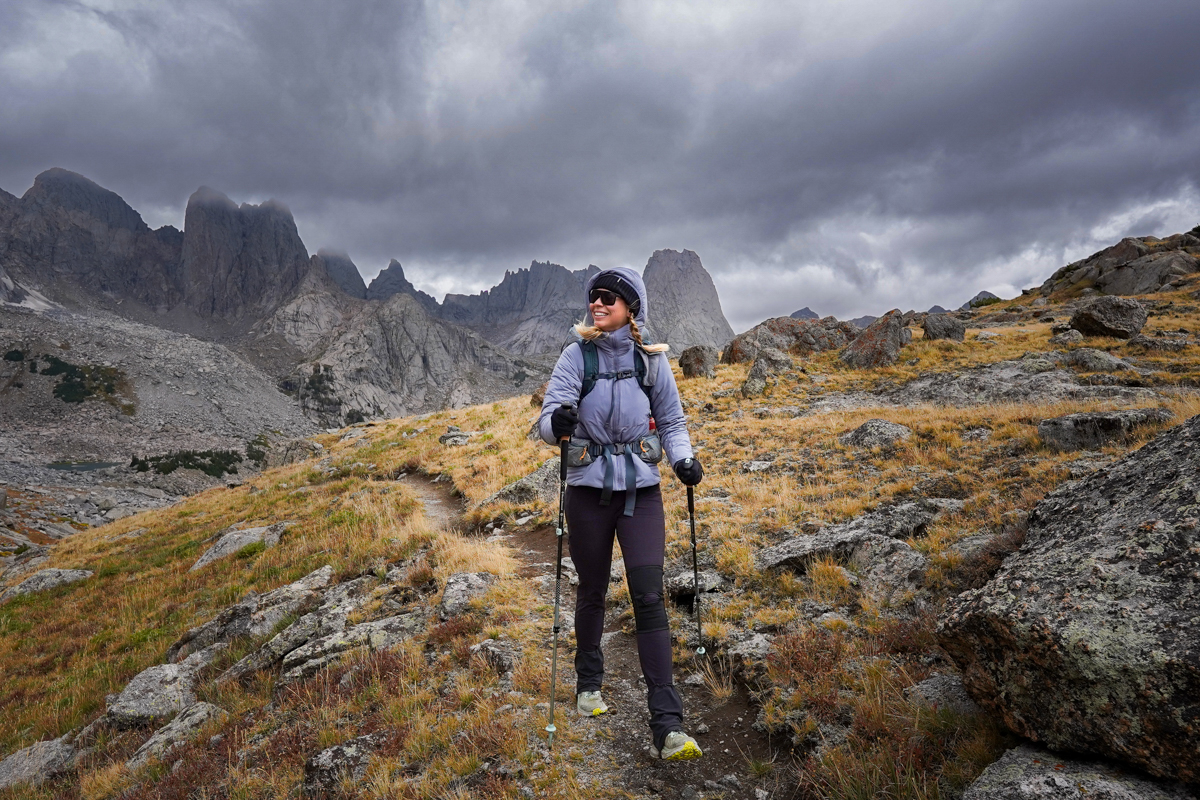
Wool Insulation
Wool—specifically Merino wool—is a popular material among baselayers due to its next-to-skin softness, impressive warmth-to-weight ratio, and natural odor-resistant properties. It’s not as common to see wool used as an insulation in jackets, but brands like Smartwool and Ortovox have expanded the market with their wool-insulated jackets. In most cases—like the Ortovox Swisswool Piz Boe jacket—the wool is spun with synthetic fibers to increase durability. While these jackets might stretch the definition of “synthetic” insulation, they perform similarly. Most notably, wool still insulates when wet, which is the biggest difference between down and synthetic insulation (down does not). The primary downside to opting for a wool-insulated jacket is price: In most cases, they cost significantly more than their true synthetic counterparts.
The single biggest selling point of synthetic fill over down fill is that it retains its ability to insulate when wet. With a down jacket, prolonged exposure to rain or snow will eventually lead to soaked feathers, causing them to lose their loft and warmth-creating potential. Even hydrophobic down technologies eventually give in to sustained moisture. A wet down jacket is heavy, won’t keep you warm, and takes much longer to dry out than a synthetic one. By contrast, synthetic insulation resists moisture—instead of being absorbed, water sits between the fibers, allowing the fibers to retain their shape, continue to insulate, and dry more quickly. The degree to which synthetic insulation resists water varies by type, but all synthetics repel moisture much better than down.
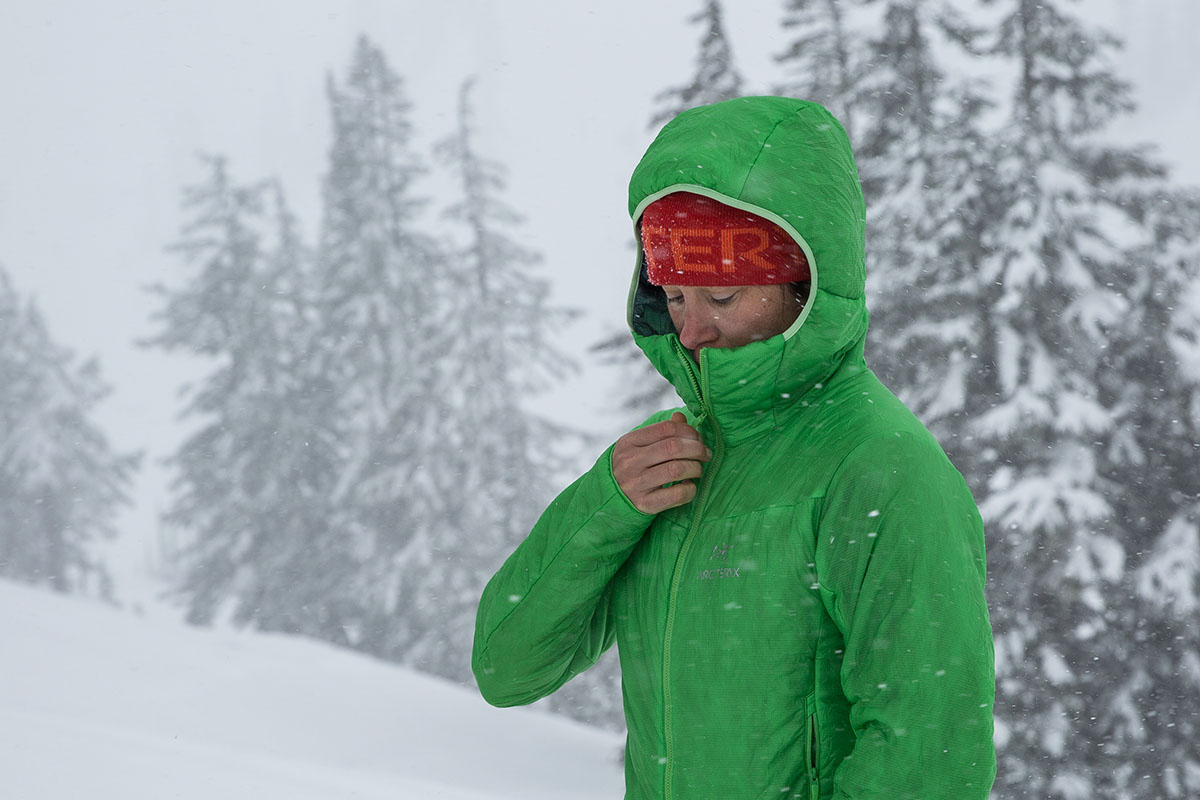
The other factor in a jacket’s water resistance is the shell material. We see quite the range here, with 100% nylon shells doing a great job keeping moisture at bay, while stretch-woven shells are more permeable to wind and rain. On both sides of the aisle, shell materials feature a DWR (durable water repellent) treatment, which causes water to bead off the shell instead of collecting and eventually soaking through to the jacket’s interior. DWR treatments do a pretty good job at repelling light to moderate precipitation, but by no means waterproof the jacket. All told, synthetic jackets do a much better job than down in wet conditions, but for prolonged exposure you’ll certainly want to bring along a rain jacket, hardshell, or ski jacket.
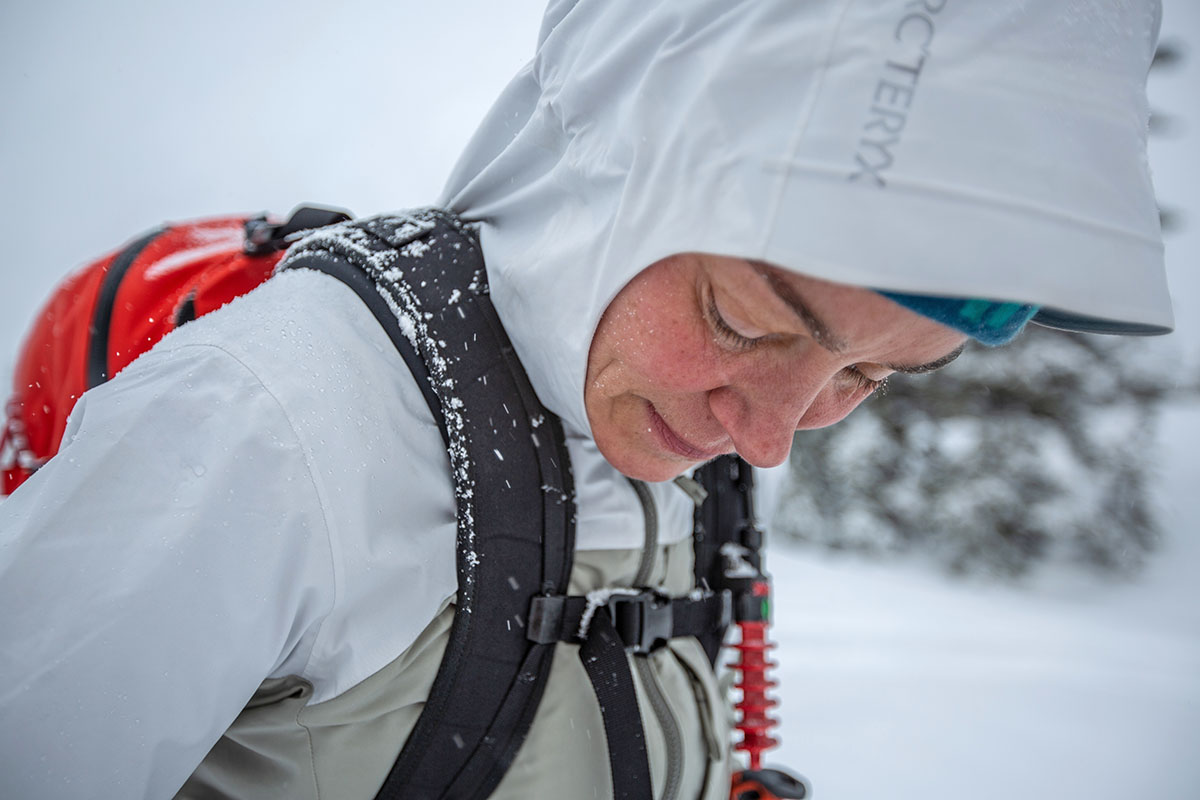
Without actually trying on a synthetic jacket, it can be difficult to discern the level of warmth it will provide. The warmth of synthetic fill is measured in terms of the weight of a 1-meter by 1-meter piece: For example, 60-gram FullRange clocks in at 60 grams for the 1-meter-squared piece of insulation. The majority of insulations are around 60- to 65-gram, but they can be significantly heavier, like the 133-gram PrimaLoft Gold Eco packed inside Patagonia's DAS Parka, or much lighter, like the Outdoor Research Deviator Hoodie's VerticalX Octa (unfortunately, OR does not specify a weight). In most cases, a larger number indicates a warmer insulation, but what this number doesn’t tell you is how much of the insulation is stuffed in the jacket—which can make a sizable difference in warmth. Here, the weight of the jacket becomes our best clue.

Most of our picks above check in around 10 to 12 ounces and provide a similar level of warmth, ideal for cool-weather fall and spring use. For freezing winter conditions, parkas like Patagonia's 1-pound-2.4-ounce DAS are true winter-weight synthetic jackets. But weight isn’t a perfect guideline: Heavier jackets like the Fjallraven Keb Padded aren’t necessarily warmer than the competition—they just feature thicker shell materials. And compared to down, synthetic insulation creates less warmth for its weight. For example, you can expect that a 12-ounce down jacket will be noticeably warmer than a 12-ounce synthetic jacket. However, down-mimicking synthetics in particular do a pretty respectable job in this department and are only getting better.

The breathability of a synthetic jacket comes down to two main factors: the type of fill and the style of shell and lining materials used. Fills that mimic down tend to breathe the least, while active insulations like Coreloft and FullRange do a great job regulating heat. In terms of the shell materials, jackets with stretch-infused or sweatshirt-like fabrics are particularly good at moisture wicking and breathability, while all-nylon shells perform the worst.
If the purpose for your jacket involves movement (like backcountry touring, cross-country skiing, or snowshoeing), active insulation pieces like the Patagonia Nano-Air, Rab Xenair Alpine Light, and Outdoor Research Deviator are great choices. These jackets deftly balance warmth and temperature regulation, and their soft shells keep mobility high. But it should come as no surprise that they are by nature more air-permeable, meaning they don’t trap heat as well as down or down-mimicking synthetic jackets. On the other hand, if you’re aiming for all-out warmth in a heavyweight design, expect breathability to suffer.
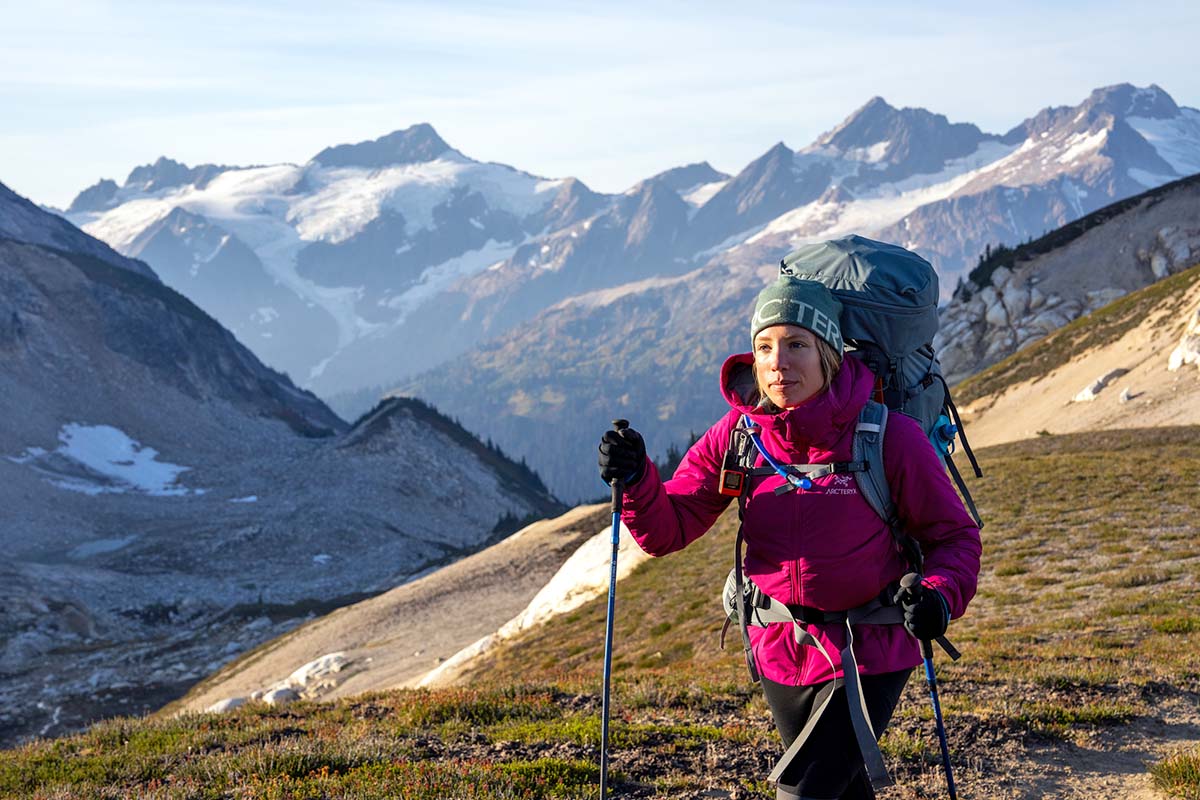
Synthetic insulation doesn’t compress quite as tightly as down, but recent improvements make it more impressive than ever. In general, down-mimicking jackets like the Micro Puff have smaller packed sizes than active pieces like the Nano-Air, due to the makeup of both the insulation and shell fabrics. Regardless of their packed size, most of the synthetic jackets on this list either pack down into a pocket or come with an included stuff sack. If packability is your highest priority, we still recommend a down jacket, but for casual use and adventuring when space isn’t at an absolute premium, synthetics aren’t far behind.
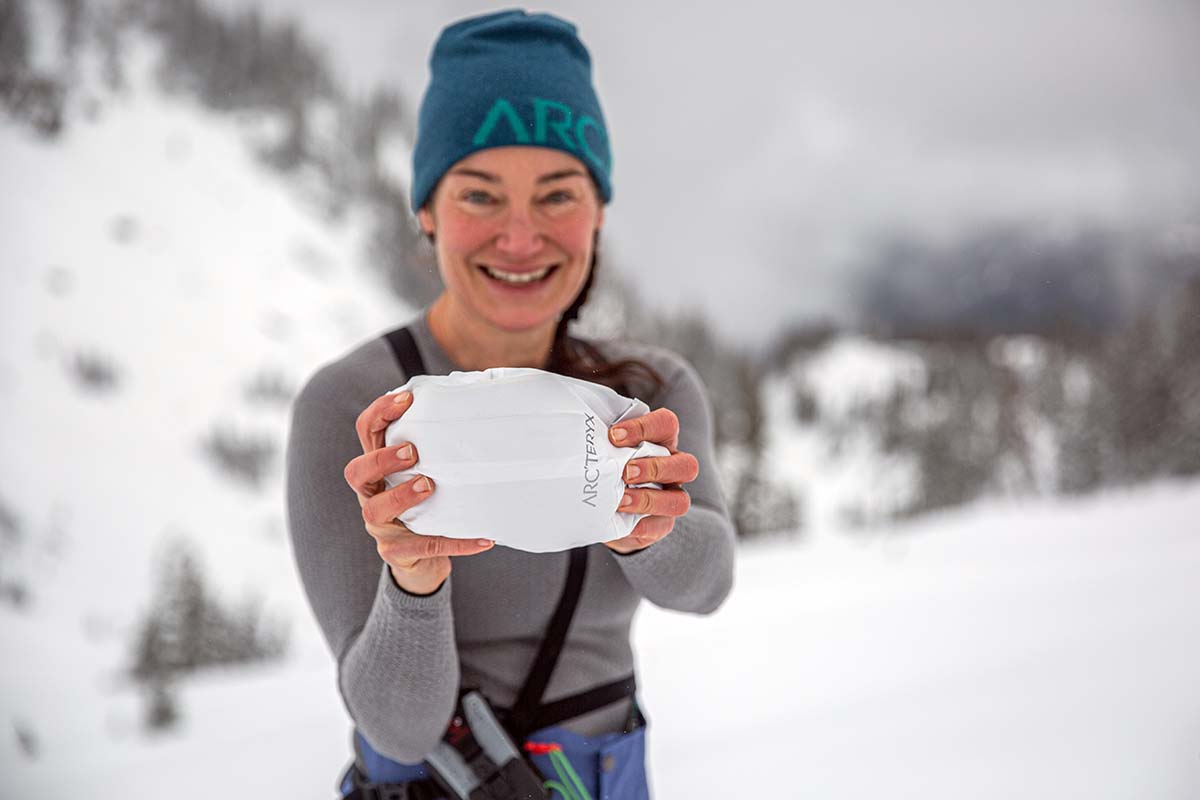
Synthetic jackets might not offer the sleeping-bag loft of down jackets, but they still have a lot going for them in terms of comfort. First is their ability to effectively regulate body temperature: Synthetic fill is decently breathable (a lot more so than down), which means it can adapt well to various environments. We can walk the dog in 45-degree weather, then move indoors to the office without missing a beat. What’s more, many synthetic jackets (like the Arc’teryx Atom or Patagonia Nano-Air) feature soft, sweatshirt-like shells that feel like your favorite hoody or fleece jacket. In contrast to a comparable down jacket like the Arc’teryx Cerium, they’re less bulky, quieter, and easier to move around in. It’s certainly hard to beat down in terms of coziness, but synthetic jackets are by far our preferred choice for all-day wear.
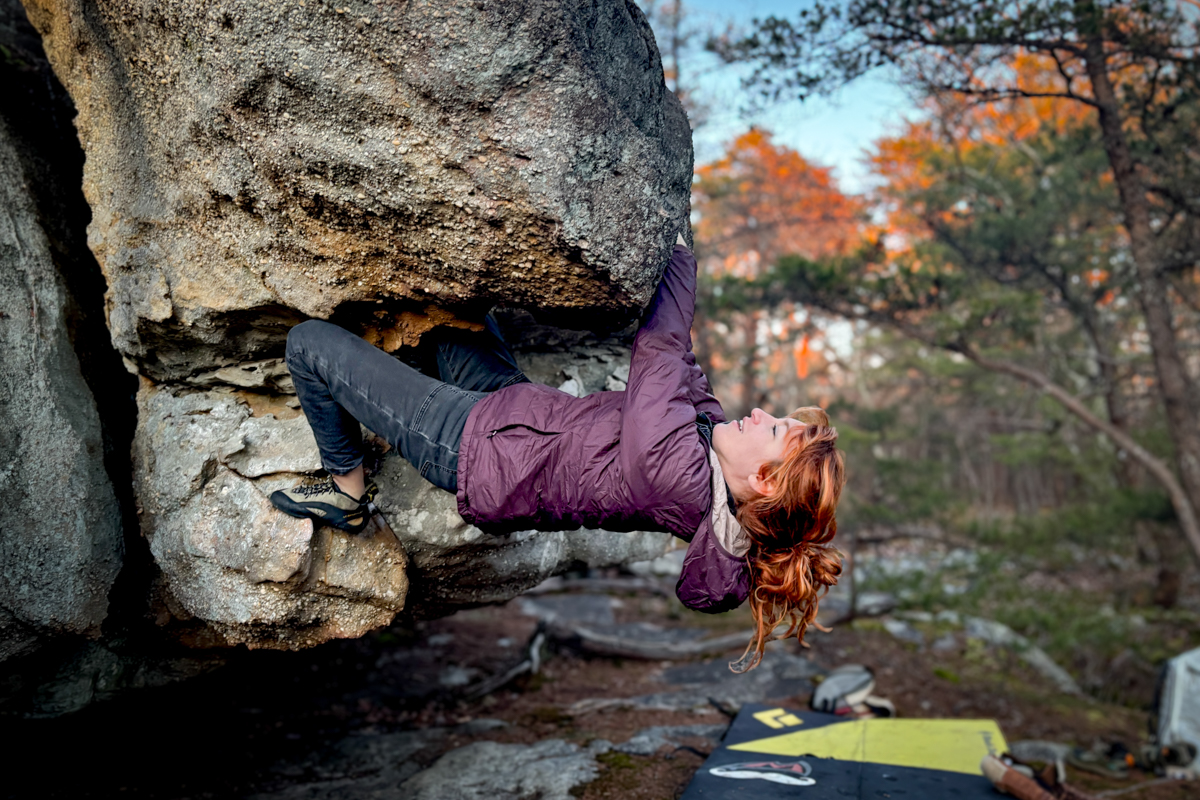
Women's synthetic jackets range widely in terms of fit. Most performance pieces are built to wear overtop a baselayer or thin midlayer and easily layer underneath a rain jacket, hardshell, or ski jacket. However, some performance pieces, like the Outdoor Research Deviator and Patagonia Nano-Air Light Hybrid, have a particularly trim cut that removes excess fabric for added mobility, efficient ventilation, and easy layering. On the other hand, heavyweight jackets like the Fjallraven Keb Padded Hoodie are noticeably roomy. If you’re in search of a jacket adept at both, an option like the Arc'teryx Atom may be the ideal choice, with enough room to be comfortable but not so loose as to be useless in the backcountry. Or, you can size up: We wear the Patagonia Nano-Air Light Hybrid in a size medium rather than our standard size small, which adds versatility for a variety of uses.
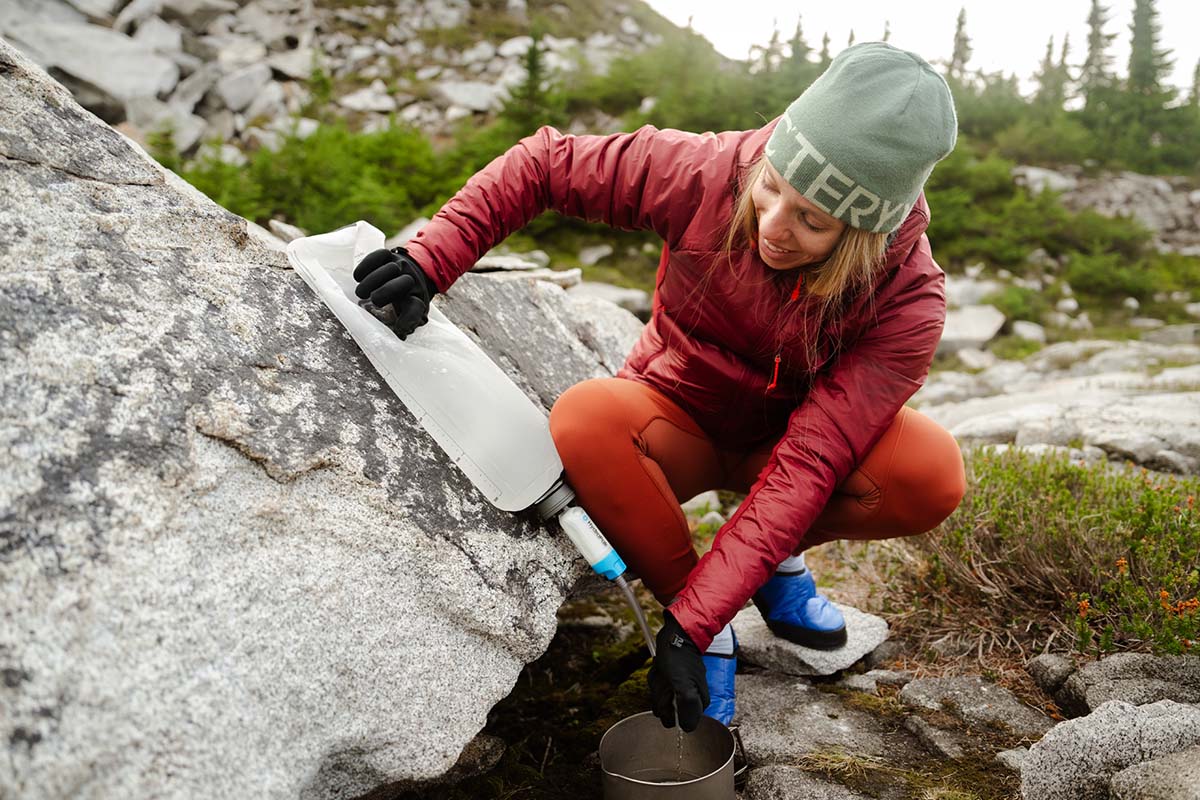
Many of our top-ranked synthetic jackets are offered in either a hooded or non-hooded style, and what’s best for you will come down to use. We reach for an insulated vest or non-hooded jacket as a midlayer while skiing or around town, and the hoody is great as an outer layer or if it’s really cold. It’s also worth considering what other layers you plan to wear with your synthetic jacket, and whether or not they have hoods—pairing three mid- and outer-layer jackets with hoods can result in quite the pileup. Expect to pay up to $50 extra for the hoody version of the same piece. A down jacket purchase shares many of the same considerations, and we’ve covered this question in greater detail in the article: Does Your Down Jacket Need a Hood?
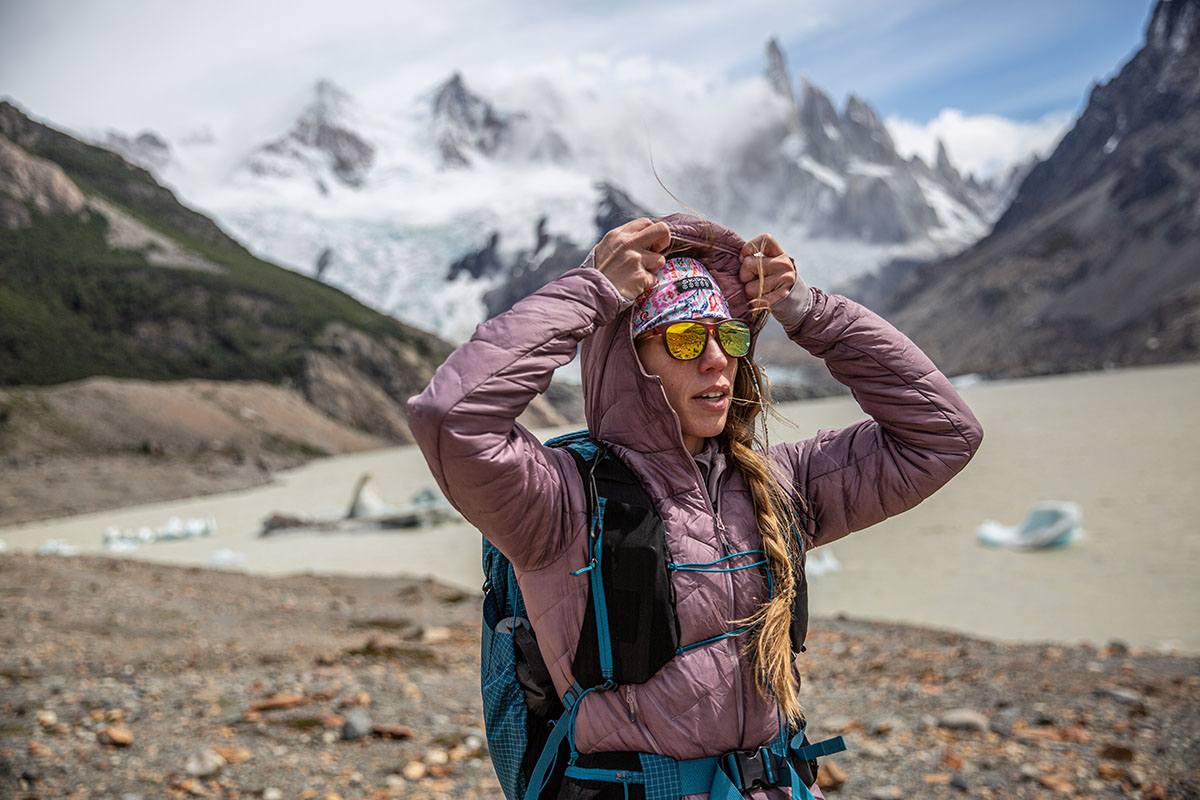
One big selling point of synthetic jackets is that they are easier to care for than down jackets. First, you don’t have to worry as much about moisture, and they don’t lose feathers, meaning that you don’t have to be as vigilant about keeping a close eye on your jacket. Second, many synthetic jackets have relatively thick shells with some built-in stretch (including designs like the Patagonia Nano-Air and Arc'teryx Atom Insulated Hoody), which lends great durability for everyday wear. And finally, most synthetic jackets are machine washable and don’t require special supplies and care for cleaning.
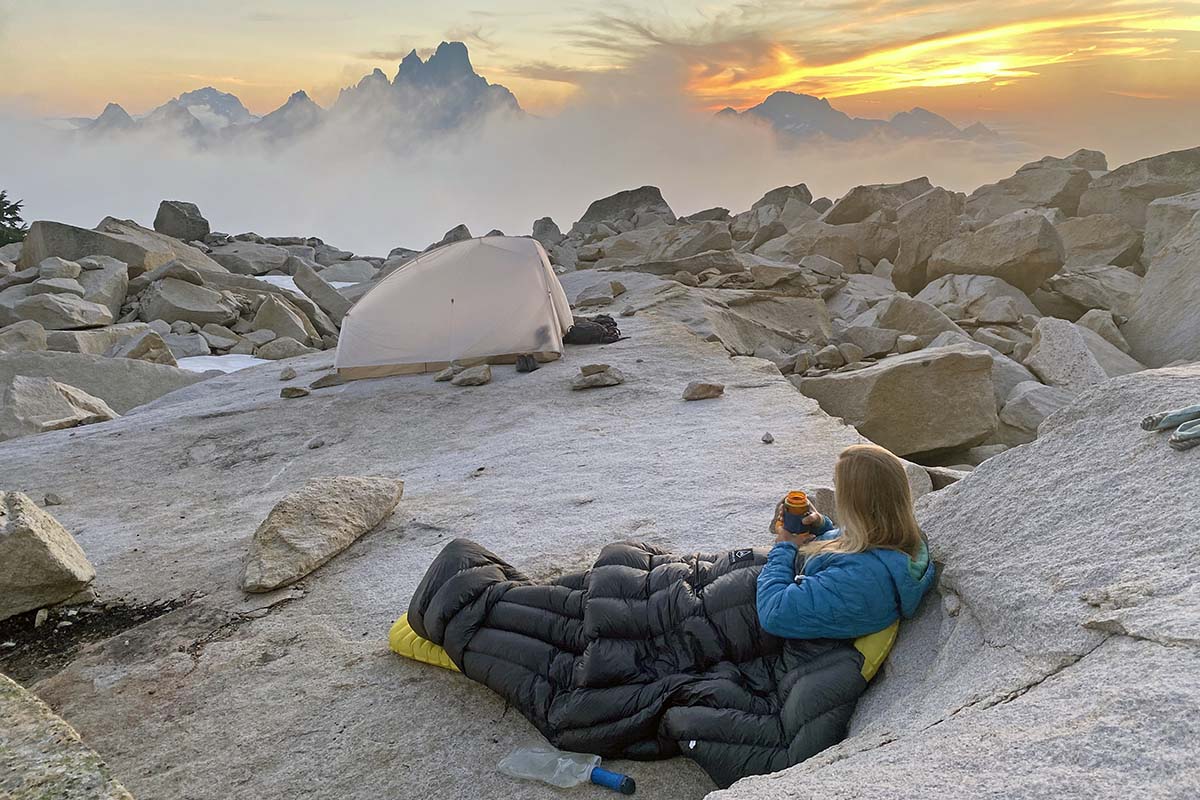
However, it’s important to note that synthetic insulation will break down over time, causing it to lose its loft and ability to trap heat. In this respect, it’s a much less durable product—we have down jackets passed down from our parents that are arguably just as warm today as they were 40 years ago. On the other hand, synthetic jackets certainly have a shorter lifespan and their insulating capabilities will not last throughout generations.
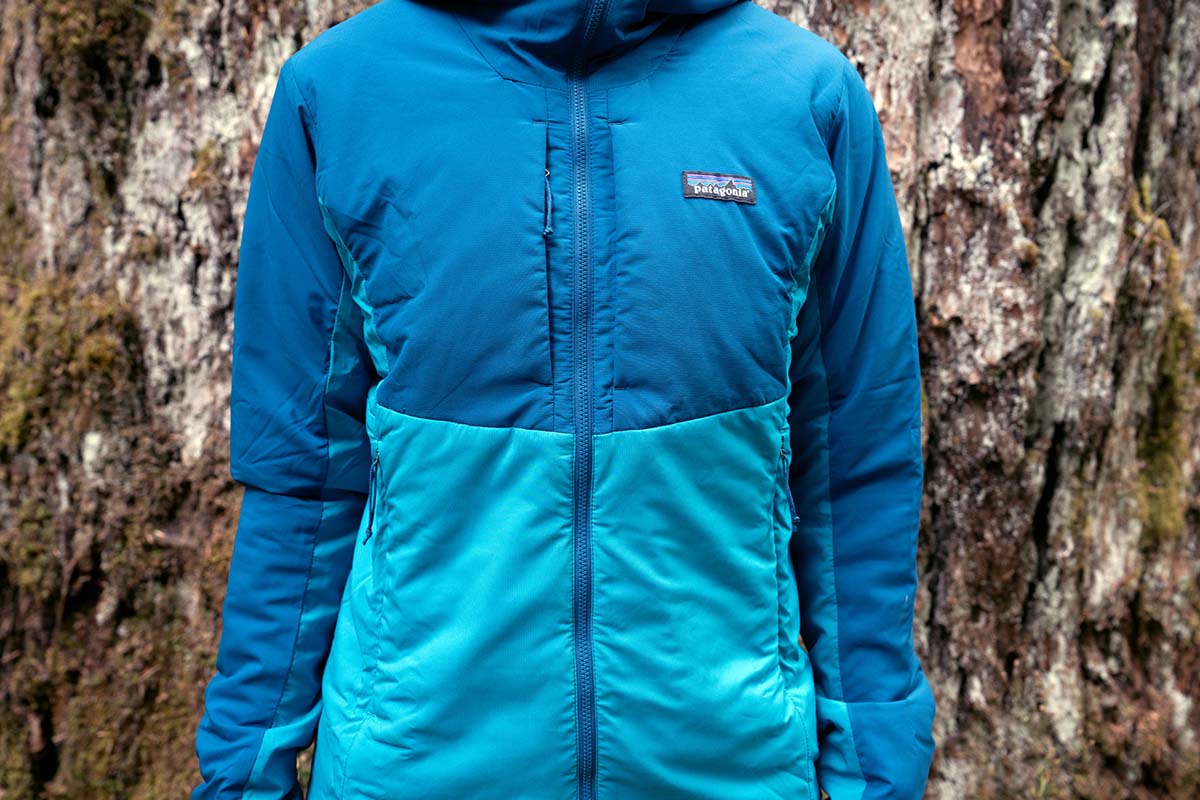
Synthetics have been less scrutinized than down—particularly by animal rights activists—but they have their own set of issues. For one, most are petroleum-based, which results in greenhouse gas emissions and potentially unsafe work environments. Many manufacturers have attempted to make their production more sustainable by using recycled materials, which is a great start (most jackets here are built primarily with recycled shell materials and fill). To add to the debate, some synthetic fills release micro pieces of plastic into the water during each wash, an issue that is becoming more and more of a global problem—a wash bag (like this one from Guppyfriend) can help keep your wastewater plastic-free. In the end, the most sustainable solution is to buy nothing at all and do what you can to extend the life of what you already own. And if you do make a purchase, we encourage you to be a responsible consumer and choose products made with a sustainable ethos.

If you’re looking for a warm yet lightweight jacket, your choice will be between down or synthetic fill. Thankfully, the two materials have fairly different attributes that can help ease the decision. As we’ve touched on above, synthetic’s primary strength is its water resistance—even when wet, synthetic fill maintains its loft, and thus can continue to insulate. Certain varieties of synthetic fill are also relatively breathable, especially those used in active insulation, and their sweatshirt-like shells can be a lot more comfortable for all-day use. Finally, due to the sheet-like nature of synthetic fill, you don’t have to baby your jacket as much as down. Thus, if we’re anticipating inclement weather, plan to build heat in cold conditions, or know we’ll be wearing our insulation as an outer layer while rock climbing, we’ll take along a synthetic jacket.
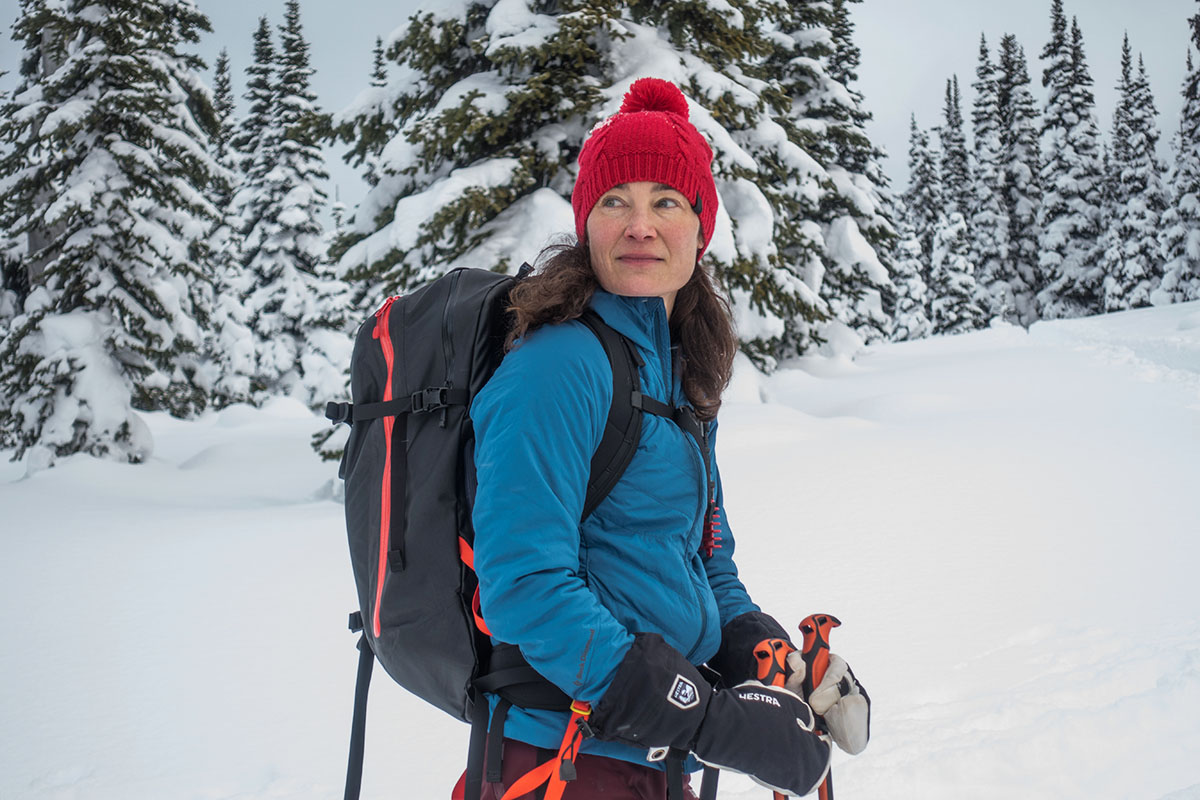
Down, on the other hand, excels in two primary metrics: warmth-to-weight ratio and compressibility. Materials engineers are getting closer and closer to creating a synthetic fill that’s as lofty as down (Patagonia’s PlumaFill is an impressive impersonation), but there’s still no substitute for the real thing. As a result, down jackets are able to offer more warmth for a lower weight and packed size, which is especially important for fast-and-light activities like mountaineering, backcountry skiing, and fastpacking. They’re also arguably more cozy—akin to wearing a sleeping bag—and unlike synthetic jackets, will not pack out over time. The choice can be a difficult one, but if we anticipate dry conditions, know we’ll only be wearing our insulation at rest, and need to prioritize a minimal weight and bulk, we’ll turn to down. For a more detailed explanation of this topic, see our article on down vs. synthetic insulation.
Back to Our Top Synthetic Jacket Picks Back to Our Synthetic Jacket Comparison Table